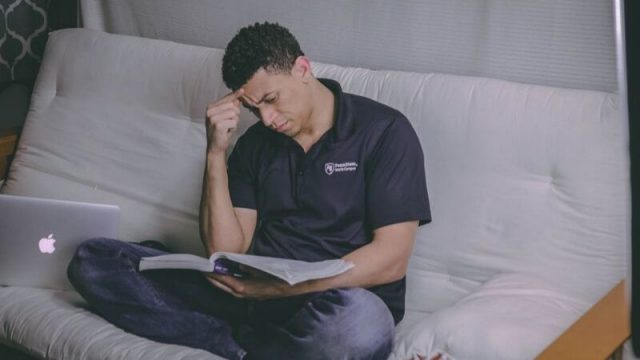Advertiser Disclosure
Is Your Student Loan Forgiveness Invalid?
Updated On November 2, 2021
Editorial Note: This content is based solely on the author's opinions and is not provided, approved, endorsed or reviewed by any financial institution or partner.

This is not an April Fool’s joke.
If you are counting on Public Service Student Loan Forgiveness – the federal program that forgives your student loan debt after 10 years of qualifying work in public service and 120 consecutive student loan payments – then pay close attention.
Is Your Student Loan Forgiveness Invalid?
As first reported by the New York Times, a student loan borrower’s acceptance into a federal student loan forgiveness program may not be binding and could be rescinded by the U.S. Department of Education.
In a legal filing March 23, the Education Department said that student loan borrowers could not rely on the approval letters sent by the program’s administrator, FedLoan Servicing, because any approvals are considered tentative.
Four student loan borrowers (and the American Bar Association) sued the Education Department to seek reinstatement of their eligibility for the Public Service Loan Forgiveness Program. The plaintiffs claim they initially qualified for Public Service Loan Forgiveness, only to have the decision subsequently reversed.
“The [U.S. Department of Education]’s response is illogical, untenable and bewildering,” Linda Klein, president of the American Bar Association, told the New York Times. “[An unreliable certification system] exposes those undertaking public service work – exactly what Congress intended them to do – to crippling financial risk.”
So, you now work in public service – or plan to work in public service. What does this all mean and what should you do?
Here is what you need to know about public service student loan forgiveness:
1. Understand How Public Service Student Loan Forgiveness Works
The Public Service Loan Forgiveness Program is a federal program that forgives federal student loans for borrowers who are employed full-time (more than 30 hours per week) in an eligible federal, state or local public service job or 501(c)(3) non-profit job who make 120 eligible on-time payments.
There are only two types of federal student loans that qualify: Direct Loans (such as Stafford Loans) and a Federal Direct Consolidation Loan. Therefore, private student loans are not eligible.
Today, more than 550,000 have signed up for Public Service Student Loan Forgiveness.
It is important to note, however, that no student loans have been forgiven yet under this program, which began in 2007 and requires 10 years of employment in public service.
The U.S. Department of Education has not released the application for Public Service Loan Forgiveness, although it is expected to be available before October 2018 (the date when the first borrowers become eligible, since this date is 10 years after the start of the program).
In order to be eligible for Public Service Loan Forgiveness, you have to make the majority of the 120 student loan repayments under an income-driven repayment plan.
2. This Is An Individual Lawsuit With Specific Circumstances
You don’t need to panic that suddenly your years of hard work in public service will not result in student loan forgiveness. This lawsuit involves individual litigants with specific, unique cases.
Therefore, their circumstances may not apply to you.
3. Choose Your Employer And Type of Employment Carefully
The Consumer Financial Protection Bureau estimates that 25% of the U.S. workforce is employed in public service, and many of those employees may be eligible for some form of student loan forgiveness, including Public Service Loan Forgiveness.
For example, one of the litigants in the case worked at a non-profit organization.
While the Public Service Student Loan Forgiveness program includes employment at a 501(c)(3) non-profit organization, not every non-profit or type of employment qualifies.
Keep that in mind when considering Public Service Loan Forgiveness, your employer and position. If you are unsure whether an employer or role would qualify for Public Service Loan Forgiveness, then you may want to look at alternative options that you know would qualify.
Of course, this begs the question that how do you know if your employer qualifies if you are allegedly told it does and later find out it does not? In this circumstance, there is no bright line rule.
This lawsuit may provide some insight. The Education Department also may provide more clarification as the program starts to forgive student loans.
4. Public Service Student Loan Forgiveness Should Not Be Your Primary Reason For Entering Public Service
If your calling is to work in public service, thank you for your commitment to serve our country and for your sacrifice.
However, entering a public service career to have your student loans forgiven after 10 years should not be the driving force for your decision.
Over the course of 10 years, the program’s rules may change and it is possible that the program looks different than when you started your public service career.
It is also possible the program does not exist in its current form, or at all.
5. The Trump Administration May Change Student Loan Repayment
Last October, then-candidate Donald Trump proposed an income-based repayment plan that would allow student loans borrowers to cap their monthly student loan payments based on their income and then have their student loans forgiven after a certain period of time.
Currently, under the Pay As You Earn (PAYE) and Revised Pay As You Earn (REPAYE) income-driven repayment plans, you pay 10% of your discretionary income each month toward your federal undergraduate student loans for 20 years, at which point any remaining balance on your federal undergraduate student loan is forgiven.
Under REPAYE, if you have graduate school student loan debt, the repayment period is 25 years before your remaining student loan debt is forgiven.
During the presidential campaign, Trump said he would combine the existing repayment plans into a single plan to make it less confusing for borrowers.
While Trump’s proposal raises the monthly payment cap from 10% to 12.5% of income, his proposal forgives the remaining student loan balance five to 10 years sooner than the current income-driven repayment plans.
How does Public Service Loan Forgiveness program fit within this framework?
While the Trump administration has not enacted these proposals, the future of the Public Service Loan Forgiveness program is less clear.
The program could be continued, modified, eliminated or folded in to a new repayment plan program.
If Congress were to eliminate Public Service Loan Forgiveness (and place all borrowers into a single income-based repayment program), for example, existing borrowers likely would be grandfathered in, since they borrowed with the expectation of entering public service and qualifying for loan forgiveness.
Public Service Loan Forgiveness alternatively could be restricted by capping the amount of loan forgiveness, restricting the eligible fields or establishing a means test for forgiveness.



